“Cultural heritage is an important driving force for the development of the country. Heritage belongs to the past, so it is easy to be ignored. Therefore, it is always necessary to be creative and active in conservation so that the heritage is valuable for life and contributes to sustainable development…” – President Nguyen Xuan Phuc shared when he was still the Prime Minister at the “Conference to protect and promote the value of Vietnamese cultural heritage for sustainable development” on July 27, 2018. Agreeing with that point of view, Assoc. Prof. Dr. Bui Minh Tri – Director of The Research Center for Imperial Citadel had an exchange with Capital Security about the digitization journey to preserve the heritage that he and his colleagues have pursued for many years.
Capitals or citadels were the names given to the country’s primary administrative centers in ancient medieval history. These are the centers of political, economic, and cultural power, and they play a vital part in the nation’s formation and evolution. Today, Vietnam has three important historical and cultural sites. This is referred to as “Dai Viet Culture” in the north, “Champa Culture” in the center, and “Funan Culture” in the south. These are three crucial elements that contribute to the identity of the Vietnamese nation’s culture, civilisation, and history. Except for the Hue Citadel, the ancient capitals of Vietnam were largely destroyed by historical events. As a result, archaeological study to digitization is critical for evaluating the history of the existence and growth of capitals.
More than twenty years have passed since the discovery of archaeological remains at the Imperial Citadel of Thang Long until now. This is a system of interwoven architectural relics from many historical periods. Millions of thousand-year-old relics were found in the mysterious underground. According to archaeologists and senior researchers who have been associated with the Imperial Citadel of Thang Long for more than 20 years, there are too many meaningful lessons here, drawing countless experiences, from time and work, material … in the work of archeology, conservation, preservation and promotion of cultural heritage; in which there is a particularly important direction “DIGITALIZATION OF THE HERITAGE” on the way to “BRING BACK THE HISTORY”.
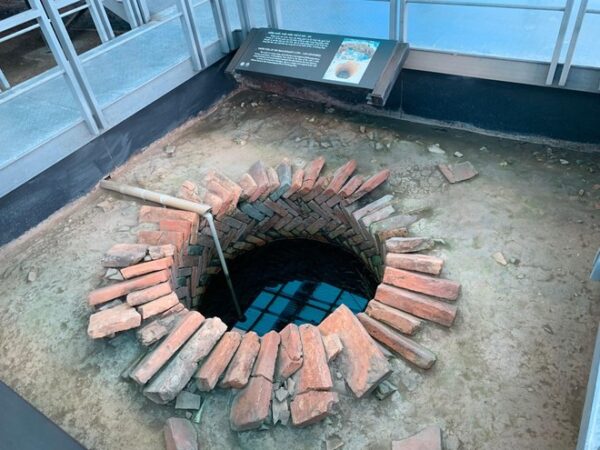
Archaeological site at Imperial Citadel of Thang Long
Social responsibility
– Reporter: The Research Center for Imperial Citadel is an organization that actively uses digital technology solutions to research, protect, and promote the value of cultural heritage, especially Thang Long’s Imperial Citadel. Currently, many facilities and localities wish to learn this as well, but they confront budget challenges. This is a significant challenge to overcome. Do you believe Thang Long’s Imperial Citadel can do it because it has priority over them?
– Assoc. Prof. Dr. Bui Minh Tri, Director of the Research Center for Imperial Citadel: Nowadays, it is a fact that people talk about money in everything but forget about perception and vision. The root and heart of any issue lies there. I believe that we can only see where the money is and how to get it when the two conditions of awareness and vision are met. People frequently give the justification that they can only do this because they have little or no money. It serves as an explanation for something they themselves can’t do or don’t do well.
I’m not saying all of them, but if we go to a few museums and we’ll see how gloomy it is. There, the heritage value is not highlighted. As a result, the people do not understand, so how to make them love the heritage? We recognize heritage, but if we simply recognize it without taking measures to preserve and promote its value, what is recognition for? If so, it will eventually become a wasteland. In conclusion, having recognized and ranked, it is necessary to have an investment strategy for the heritage so that in addition to conservation, it also promotes economic, cultural and social development. We can’t just recognize legacy for the sake of duty, take credit for it, and take no responsibility. Regarding supervision after recognition, many places neglect and leave the responsibility to the establishment and the locality. Meanwhile, there are also many localities indifferent to the heritage.
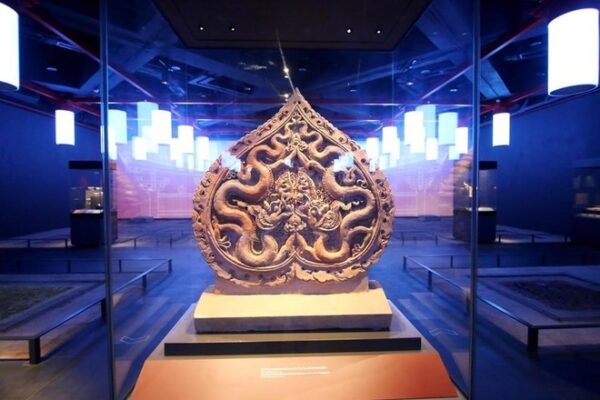
The exhibition space of the Ly Dynasty Palace architecture in the basement 1 of the Archaeological Exhibition Area in the basement of the National Assembly House (Source: The Research Center for Imperial Citadel)
– You just mentioned awareness and vision, so how important is it in preserving and promoting the value of the nation’s cultural heritage?
– Many localities have relics and cultural heritages and also want to preserve and promote its values, but desire is one thing, ability to dois another. I remember the story of the Imperial Citadel of Thang Long in the early days, there were many challenges. At that time, we had to present awareness of the heritage value to the Party and State leaders and persuade them to preserve this archaeological heritage for future generations. When the Imperial Citadel of Thang Long became a world cultural heritage, a strategic vision was opened for the promotion of heritage values, which shows that these perceptions were correct.
At that time, Ms. Irina Bokova – Director General of the United Nations Educational, Scientific and Cultural Organization (UNESCO) affirmed: “Very few countries in the world can preserve living memories about establishing a capital 1,000 years ago without being lost over time. The Imperial Citadel of Thang Long being recognized as a world heritage is an honor, and also brings about your commitment. You have a responsibility to humanity in promoting, protecting, and passing on this legacy to your descendants so that they will continue to tell the next generation the story of King Ly Thai To”.
Awareness and vision in conservation and promotion of heritage values must be parallel, objective, close to reality and for greater things for the nation and nation. Each person must put aside individuality to be more responsible, because the strategy has been built, no party can be indifferent. The same was true of the former Thang Long Imperial Citadel. Excavations before 2000 were still obscure, in 2004 there were heated debates and by 2008 there were still negative opinions.
Digitization must analyze the background, meaning and historical value of the heritage
“Digitalization is simple if considered only from the perspective of documents, but in order to perceive it deeply, it is also the work of researching and evaluating the value of artifacts to put in the record, viewers must understand what it is. Digitization is about analyzing background, meaning, and value, building a relevant historical story associated with the story of the times, and making viewers feel the depth. That is not to mention that digitizers must be qualified to conduct the digitization in an attractive and targeted manner. Otherwise, viewers will only compliment one sentence that the artifact is beautiful, and that’s it.”.

Assoc. Prof. Dr. Bui Minh Tri (Director of the Research Center for Imperial Citadel)
Lack of standardization background
– In your opinion, if we can digitize cultural heritage, what positive aspects will it bring to society??
– The topic of digitalization in archeology alone has met to raise public awareness of the worth of vanished cultural heritages. This has a positive impact on promotion, conservation, and socioeconomic growth. However, we keep talking about digitization, but how many people truly understand what it is? Is digitalization really that simple? As previously stated, numerous establishments and communities aspire to learn and duplicate the model of digitizing Imperial Citadel of Thang Long. To do so, however, a system must be built, standardized software must be developed, and the databases must follow the correct and standard form in order to connect with others. But how can they be unified if everyone does what they want? I’m thinking of another global problem, which is that it’s impossible to be different from the world. Of course, every nation must have its own identity, but international languages must also be taken into account.
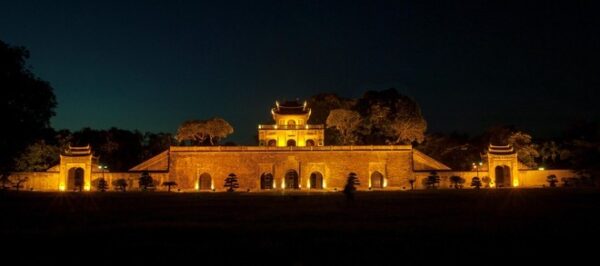
Imperial Citadel of Thang Long
Digitalization is simple if considered only from the perspective of documents, but in order to perceive it deeply, it is also the work of researching and evaluating the value of artifacts to put in the record, viewers must understand what it is. Have you ever asked the question: Why is it not as simple to announce an artifact of a foreign country as in Vietnam? What is the difference here? For example, people display an artifact as a stone pedestal and with a short description: “This is a stone pedestal of the Ly Dynasty”. But then the viewer will not understand anything. Digitization is about analyzing background, meaning, and value, building a relevant historical story associated with the story of the times, and making viewers feel the depth. That is not to mention that digitizers must be qualified to conduct the digitization in an attractive and targeted manner. Otherwise, viewers will only compliment one sentence that the artifact is beautiful, and that’s it.
“The goal of heritage digitization is to preserve existing value or a part of existing history. Thanks to digitization, we can see an entire civilization that has perished. Therefore, the goal of digitizing cultural heritage should be set at the national level to serve the long-term strategy of cultural development”.
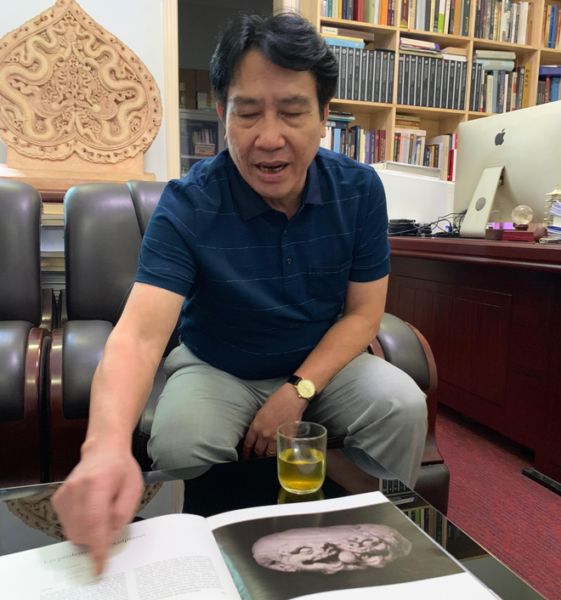
Assoc. Prof. Dr. Bui Minh Tri (Director of the Research Center for Imperial Citadel)
Ever since we released the mock-up of the Imperial Citadel of Thang Long, I’ve been very proud. It is also a stimulating factor that attracts many young people to pay attention and participate in research. Not to mention exactly or not, but at least they have plans and drawings. That leads to debate, criticism, complementing different views and perspectives, and perfecting and finding the truth. When we digitize the Imperial Citadel of Thang Long, we also face many challenges. Many people said that when we made the heritage profile, we could show the drawing of the Ly dynasty that they had already seen the results. But they don’t know that we have to spend a lot of time deciphering from the tile to the column, there must be a quantification, a name, understanding the function to put it on the roof, from which there is enough data to interpret the architectural form. All those small, detailed things combined with international research can produce such a drawing. So I want to say, digitization is a careful research process and gathering a lot of databases.
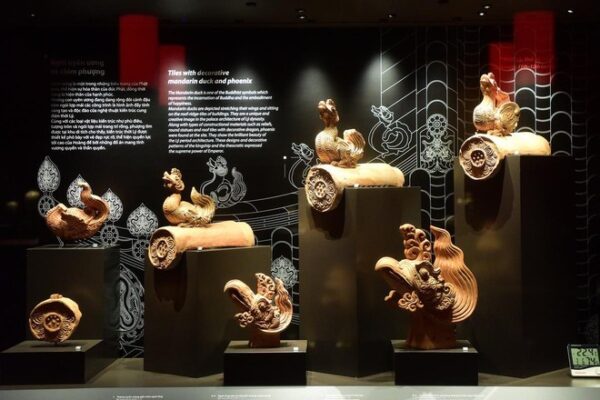
Display space of the architecture of the Ly Dynasty Palace (Source: Research Center for Imperial Citadel)
Waiting for a push
– After more than 20 years since the discovery of the archaeological remains of the Imperial Citadel of Thang Long, digitization has not yet been completed. In your opinion, can we accelerate the heritage digitization work?
– I still talk to my young colleagues that we can’t just focus on the development of the present and ignore the heritage, that is wrong. If today’s value is not preserved, it will be an expensive lesson for the future. Look at Japan, like the ancient capital of Nara. Why besides a modern city still exist the ruins of an ancient city? They discovered the traces and are continuing their investigation in order to rebuild the site one day. The Japanese have been researching for 80 years, but they still need to study.
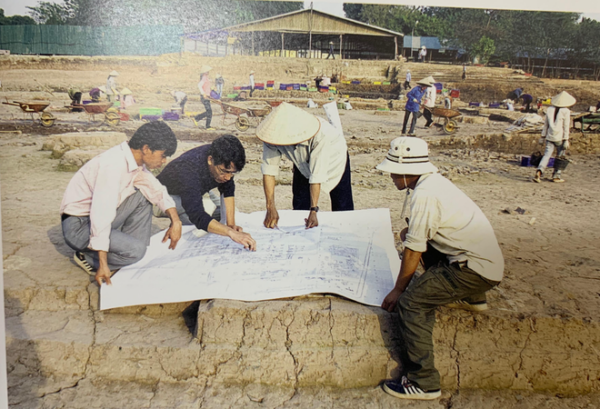
Research and analysis of architectural relics in area E – Imperial Citadel of Thang Long
It’s because, as I have stated, perception is a process. The Japanese recognize the importance of continuing research while also promoting heritage. They are gradually completed by studying, reviewing, drawing, and digitizing data. They are not in a hurry to achieve their goals. They do not do something they believe they are not qualified to do, and they do not rush since trying is broken. And once it’s broken, it can’t be repaired. A single pickaxe stroke on the ground destroys a piece of history. So it is preferable to leave it to the next generation than dig it up now. That said, the goal of digitizing heritage is towards preserving the existing value or part of the existing history. Thanks to digitization, we can see an entire civilization that has perished. Therefore, the goal of digitizing cultural heritage should be set at the national level to serve the long-term strategy of cultural development.
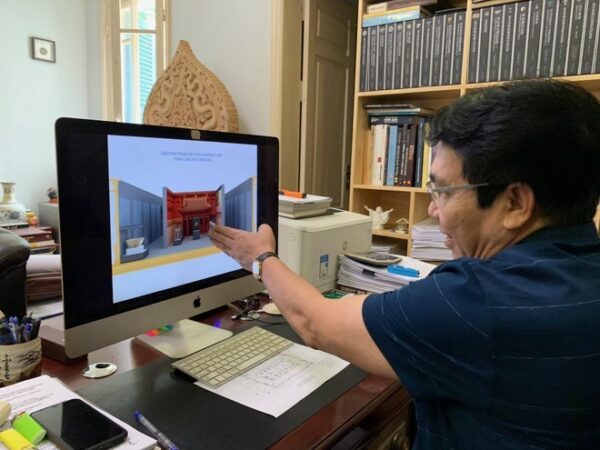
Architectural reconstruction using 3D technology of the Research Center for Imperial Citadel
– The digitization work of Citadel Research Institute is being carried out in a positive way as you just said. But I’m thinking, is it pointless when we later have a database system on national cultural heritage, but it’s not connected to what the Institute is building, sir??
– I understand this. It’s true that we don’t have a system or standards right now, but I don’t mind. What I do is to teach students, help them access modern methods, and train generations of professionals. We try to keep the fire for the legacy in the most correct and scientific way possible within the scope of our responsibility and our heart. Many generations later can also exploit this digitization. In the short term, research is the result of today’s generation in many years of accumulation. It will still exist if I disappear. I also wish there was some push to change the perception from the policy-making level. And I think this will happen soon because it’s a social trend.
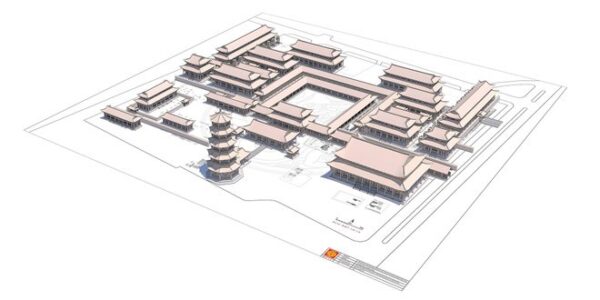
Reconstruction drawing of the form and space of the palace and attic of the Ly Dynasty in the ancient Thang Long Imperial Palace
I remember when the Ministry of Public Security built the National Database System on Population and issued Citizen ID Cards, at that time the whole political system got involved, all done very professionally despite the many steps to do, but the work is still running smoothly. It must be done in such a system to develop and manage. Digitization like the way of Public Security is to build a common house, only when there is a common house, the corner can be divided. As for the digitization of the Cultural sector, there is nothing yet. No one has yet answered what is digitization of heritage for? If you have a vision, now is the time to set a goal and make it a reality.
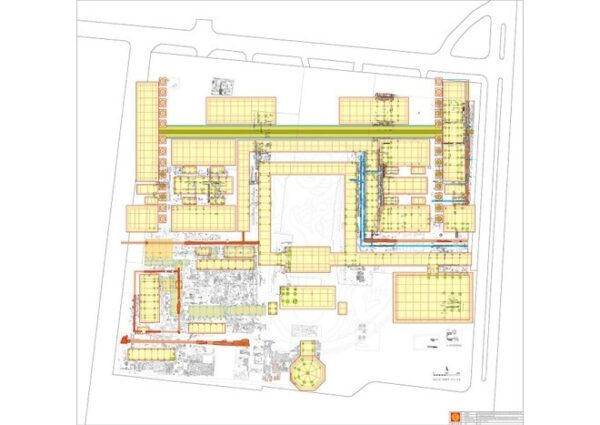
The scale drawing of the Ly dynasty palace from above
– Thank you very much for the interview!
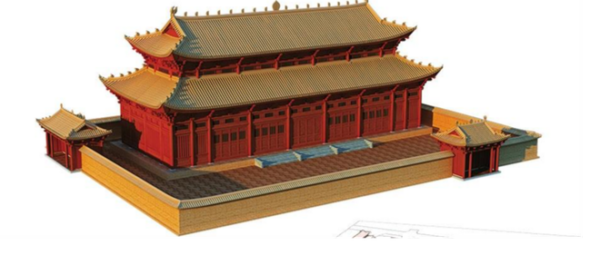
Drawing of the reconstruction of the palace architecture in the Imperial Palace of Thang Long during the Ly Dynasty
Let the heritage live forever
The United Nations defines “cultural property”, namely antiquities and works of art, as an important part of the common heritage of mankind. These are unique, priceless proofs of the evolution and identity of each people. Therefore, the importance of protecting these heritage sites has been emphasized in many international heritage conventions and national legislation. However, whether we like it or not, subjectively or intentionally, the human heritage still “disappears” completely or is damaged or decayed through the “invasion” of time, climate, war, fire… When the heritage remains, we must keep it; when it is lost, it must be restored, even if it takes decades or generations. Because heritage belongs to the past, is history, is culture, is the treasure that identifies the nation. The past is the future, in the present, that human mission is supported by digital technology so that the legacy will last forever.
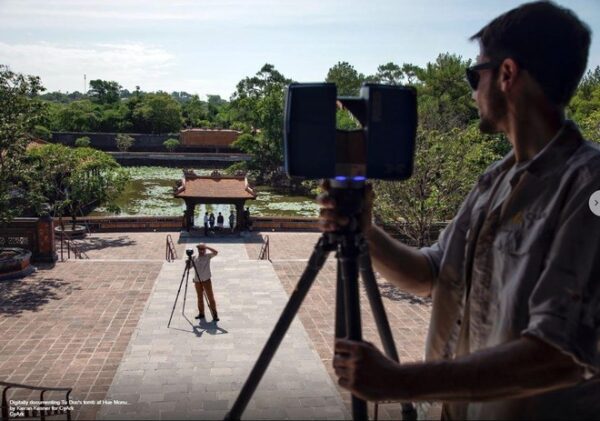
Google Arts and Culture experts are working to digitize 3D Tu Duc Tomb (Source: Google)
A Decade Story in the Ancient Capital Nara
In the story with Assoc. Prof. Dr. Bui Minh Tri, Director of the Research Center of Imperial Studies in the previous part of this writing period, he told us the story that has been happening in the Ancient Capital Nara – the first capital of Japan, the land of cherry blossoms in 710, the cultural heritage land of Japan. Nara and Kyoto are the two ancient capitals of Japan with invaluable heritage “treasures” and outstanding traditional values. Thanks to the sense of preservation and conservation from a very early age, over many generations, when coming to these two ancient capitals, many people share the same feeling that time has not ignored this place even though both have a history of more than 1,000 years.
According to experts, there are still many works in Nara that show the remarkable development of Japanese architecture and art. In particular, the monuments in Heijo-kyo are a prominent urban architectural landmark not only in Japan but also in Asian history. In addition, monuments such as temples or pagodas are also valuable documents about the strong influence of religion to this day. Thanks to not being destroyed during the Second World War, Nara still preserves many historical and cultural relics. In December 1998, the United Nations Educational, Scientific and Cultural Organization (UNESCO) included a number of historical sites and structures of Nara on the list of world cultural heritage sites.
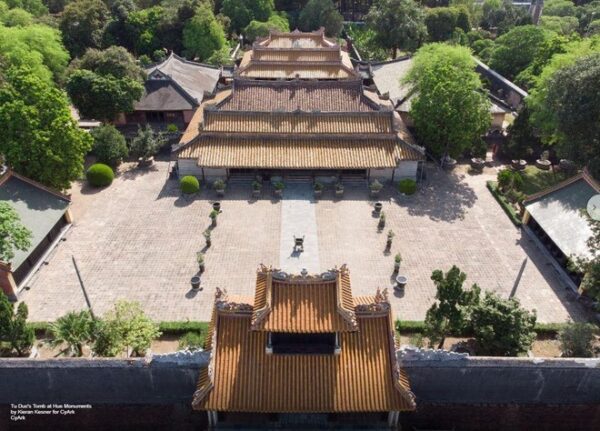
Image of Tu Duc Tomb in 3D digitized data
In Nara, there is a particularly important site – the Heijo Palace. This is an area about the size of Vietnam’s Imperial Citadel of Thang Long, buried largely underground for 1,000 years. Japan’s Heijo Palace was built to simulate Chang’an Palace (China), so when excavating and preserving, archaeologists also rely on the information of Chang’an Palace. The advantage of the Heijo palace is that it has quite a lot of information from drawings to parameters recorded by a diligent researcher.
These documents are extremely valuable for research and conservation. Heijo Palace, after being excavated, was acquired by the State and has now become a world heritage site. From 1960 to present, about 145 hectares of the palace area has been investigated, excavated and obtained a huge number of relics. The ruins in Heijo Palace after excavation were filled in for conservation. To attract visitors, the Heijo Palace is displayed in three ways: a relic gallery, a partial reconstruction of the building, and an open-air display with the relic itself.
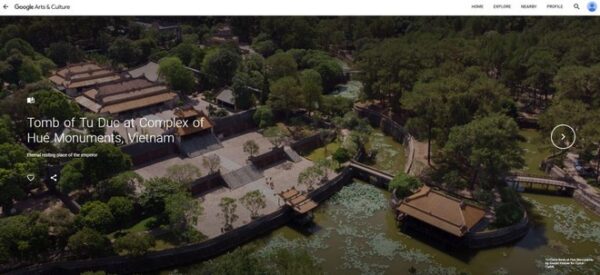
Image of Tu Duc Tomb in the 3D digitization of Google Arts and Culture
Why refer back to the story of the ancient capital Nara? Why a decades story? Because, according to Assoc. Dr. Bui Minh Tri, up to the present time, the Japanese have had about 80 years of researching the ancient capital of Nara. Decades passed, they continued to persevere in their research. That is the process of awareness, research and promotion of heritage to the people and the world. In fact, only Heijo Palace was restored, the rest went step by step, excavated, covered, and then excavated after being researched. Step by step, their drawings became thicker and thicker. Reference back to Vietnam, “to decipher the Imperial Citadel of Thang Long like Nara, it would take a few more decades” – Assoc. Dr. Bui Minh Tri commented.
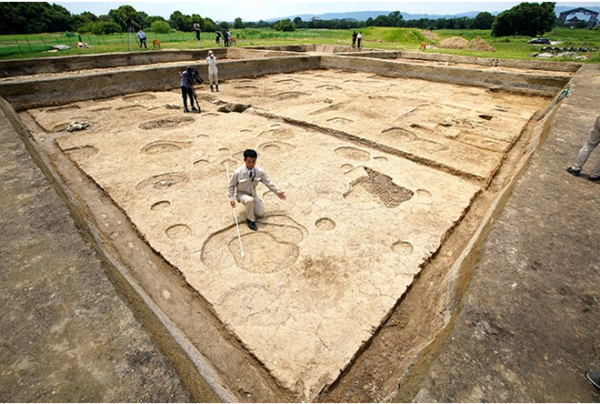
Remnants of a structure excavated at the former site of the Heijokyu Palace in the Ancient Capital Nara
According to Assoc. Prof. Dr. Tong Trung Tin, Chairman of the Vietnam Archaeological Association, when developing the planning to research, protect, preserve, and promote the values, gradual research will reveal the entire palace architecture of the Ho Dynasty Citadel, step by step develop a plan to restore and protect the landscape, diversify conservation solutions. As the case of Nara (Japan) has demonstrated, if we work hard and scientifically, we may progressively comprehend and restore Southeast Asia’s oldest capital. Gradually transforming the unexcavated treasure into one of Vietnam’s most remarkable cultural heritages, with a strong attraction to the public in the country and the world.
Perhaps, experts and archaeologists all share the same opinion, if they want to preserve and promote the value of cultural heritage, learn from the Japanese and learn diverse conservation solutions like the case in the Ancient Capital Nara (Japan) – an ideal model that any country wants to learn from so that the heritage never disappears. In particular, most of the major monuments in the world such as Nara Ancient Capital, Colosseum (Italy), Pyramids (Egypt), Dai Minh Cung (China), etc are applied 3D technology to digitize heritage in order to preserve and promote cultural values.

Todaiji – one of the famous temples and prominent symbol of Nara city
The story of 3D digitization and worldwide glorification of the Tu Duc Tomb
On the occasion of World Heritage Day April 18, 2019, Google Arts and Culture together with CyArk (Non-profit organization specializing in heritage conservation), Environmental History Scotland and the University of South Florida (USA) announced Open Heritage – is the world’s largest digital library of heritage and monuments, where anyone can access a 3D heritage archive. It is created to preserve and promote the value of world heritage, the common property of mankind in danger of being damaged or lost by nature, natural disasters or war) by adding to this platform a set of collections of stories about monuments in danger of disappearing around the world. With this project, the 3D digitized version of Tu Duc Tomb – Vietnam’s first heritage site along with 29 other world-famous heritages that are in danger of disappearing from 13 countries around the world such as the Presidential Monument American Thomas Jefferson, Mexico City Cathedral, Greek Apollo Temple, etc are included in the collection of precious relics for Google Arts and Culture to introduce to the world.
Tu Duc Tomb (Khiem Lang) is one of the most beautiful works of Nguyen Dynasty architecture. The tomb is located in Thuong Ba village, Thuy Xuan commune, Hue city. At the beginning of construction, King Tu Duc (1848 – 1883) took the name Van Nien Co for the work, but then renamed it Khiem Cung, after the king’s death, it was called Khiem Lang. According to documents of Hue Monuments Conservation Center, Tu Duc Tomb (Khiem Lang) was built in 1864 and completed in 1873. This place was originally the Royal step-over place – the resting place of King Tu Duc. The layout of the mausoleum consists of two main parts, arranged on two parallel vertical axes, with the same Giang Khiem mountain in the front as the front back, Duong Xuan mountain as the occipital bone, and Luu Khiem lake as the clear way. In the tomb, there are about 50 large and small works and it is considered as a large park in the middle of the valley.
According to Google, the inclusion of Tu Duc Tomb in the Open Heritage library began in the summer of 2018, when CyArk collaborated with Hue Monuments Conservation Center to digitize Hoa Khiem Palace, Tu Duc Tomb stele and Le Thien Anh Queen Mausoleum, providing 3D models and architectural drawings to support conservation and archival work. Accordingly, 3D and 360-degree images and videos are recorded by recording, taken from inside, outside and above from the “flycam”.
In addition, the team of experts also used laser scanners to accurately reproduce surface depictions as well as panoramic details of the campus, inside and outside the tomb and palace. According to a CyArk representative, being digitized and posted on the Open Heritage library will help Tu Duc Tomb be better advertised to the public around the world. Besides, it also makes this monument more accessible to many people, thereby helping to raise awareness of its value to history. At that time, President of CyArk – John Ristevski expressed his admiration for the incredible amount of cultural heritage that Vietnam has: “Vietnam has an incredible amount of cultural heritage. We hope to return to your country to assist heritage managers in systematizing documentation, which may include 3D digitization, and to help train this work in the many areas of heritage”.
The story in France about ‘sleeping’ digital copies
From Asia, to Vietnam, to the “Old Continent”, at 18:50 on April 15, 2019, a fierce fire broke out at Notre Dame Cathedral in Paris, France. The French people and the whole world were shocked. Paris authorities deployed more than 400 firefighters to put out the fire and try to save the main structure of Notre Dame. A serious fire has caused heavy damage to the invaluable work of Paris – standing in the middle of the “city of light” since the 1200s. Notre Dame Cathedral is a typical religious building for the Gothic style in France, also the cathedral of the Archdiocese of Paris. The church was built in 1163 and completed in 1345. Over 8.5 centuries, it has survived both world wars and is currently severely destroyed by fire.
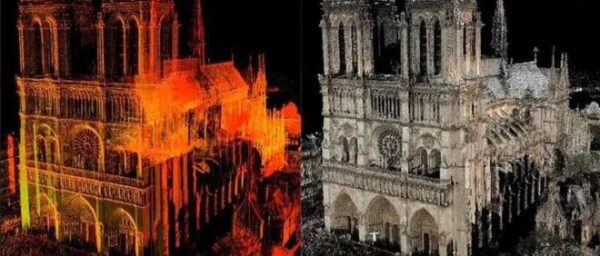
3D map image of Notre Dame Cathedral in Paris recorded by laser
At the time, French President Emmanuel Macron insisted that “the worst is over” and pledged to rebuild the building. Many French billionaires and millionaires have pledged to contribute hundreds of millions of dollars to restore Notre Dame Cathedral in Paris after the fire. However, how to restore a structure more than 850 years old? That is the story of the 3D digitization of the structure before the fire and this data will aid in the reconstruction.
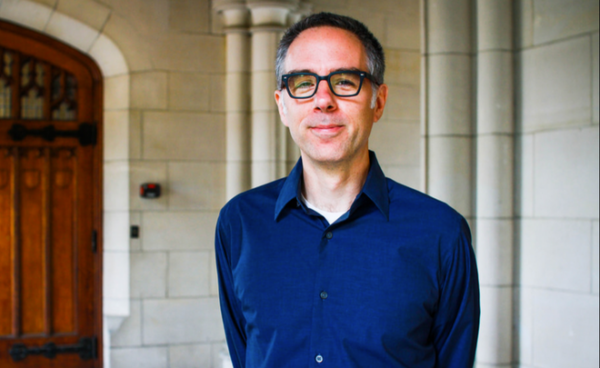
Doctor of Arts Andrew J. Tallon (1969-2018)
Before that, in 2015, Dr. Andrew J. Tallon of (1969-2018) of Vassar University (USA) and colleagues built a high-precision 3D map of the entire architecture of the building with laser scanning technology, creating a near-perfect digital replica of the Gothic structure. In addition to 3D mapping, Dr. Andrew Tallon also took a panoramic image from the same location where the scanner was located to synchronize the laser points with each pixel in the image. The result is a panoramic image that is captured with great accuracy. At Notre Dame de Paris, Dr. Andrew J. Tallon scanned from more than 50 locations in and around the cathedral, collecting more than a billion data points. To do this, the team places the scanner on a stand and the device emits a laser beam to measure the distance from the machine to every location in the building. Each such measurement is represented by a point, and the sum of these points forms a three-dimensional image of the church. “If done correctly, the error is only 5 millimeters,” said Dr. Andrew J. Tallon at the time.
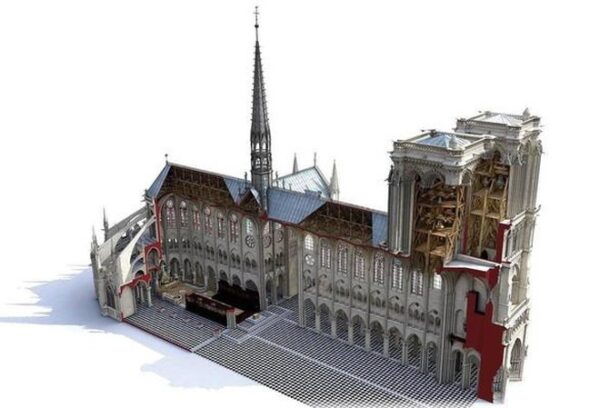
Digital image of Notre Dame Cathedral in Paris
Dr. Andrew J. Tallon’s digital model is an essential part of restoration efforts because of the precision in every detail of the cathedral before it burned. Through 3D laser scanning, he unmasks the builders’ decision and the previously unknown features of this majestic structure. For example, his scans show that the interior columns at the west end of the church were not aligned. Restoration will take years, but his scan data is invaluable to the process. The scan data will help them reconstruct the size of the lasers and the overall structure, showing how the church was built, every nook and cranny, every detail of digitization.
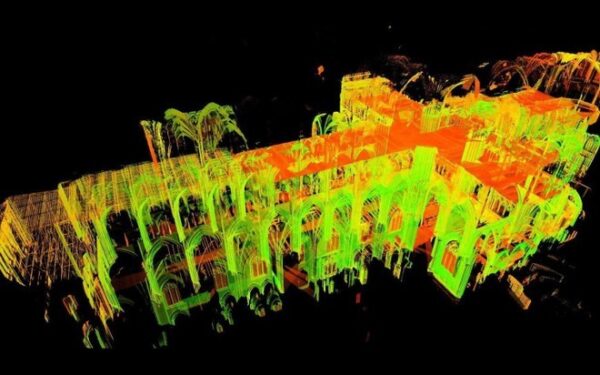
Notre Dame Cathedral in Laser Scans by Dr. Andrew J. Tallon
The more digitized versions of a map a monument has, the better. Mr. Hoang Quoc Viet, CEO of Vietsoftpro Company (the unit working with the National Museum of History to digitize 23 national treasures) shared with us that there are many groups of young people who are self-sufficient, proactive, and master technology, they have digitized a lot of cultural heritage because of their passion. The same in France, Mr. Gaël Hamon – the founder of AGP Company – has digitized more than 2,000 monuments in 18 countries in nearly 30 years of operation.

Notre Dame Cathedral in Paris, France
Since 1994, AGP Company has digitized many parts of Notre Dame Cathedral in Paris at the request of the branch office of the Ministry of Culture, the chief architect of historical monuments, conservation enterprises, but no one frame digitization required. One day, AGP was assigned to digitize the broken church headrest. At that time Gaël Hamon told the technicians to scan the church frame, because one day it would be used, even if no one ordered it, they could still do it. As time passed, the church frame digitized data “sleeped” in the computer. The tragedy of the church fire happened. Digitizing the frame of Notre Dame Cathedral in Paris by AGP Company is like a miracle, helping to restore the church as it was. With 150 scans of the tower’s frame and spire, the architects will visualize the original structure of the church down to the millimeter. Digitized versions of Dr. Andrew J. Tallon, Mr. Gaël Hamon… are valuable documents for architects to compare the church architecture before and after the fire during the restoration process.
Through the story of the world, the story of the world coming to Vietnam to digitize the heritage, the story of Vietnam digitizing the heritage from the policies, dreams, hardships… that we mention in this series of articles, it can be seen that although there is still a long way to go in terms of technology, people, experience and especially research results collected in reality, it is clear that the restoration of monuments by 3D technology to preserve, promote heritage values will still be one of the reasonable directions in the future to “awaken” the relic, revive the heritage and bring back the history.
(Continues)
Vân Quế- Tả Minh- Trần Quân- Tuấn Dũng

